Please allow 21 days for processing.
If you have paper or temporary license plates, please wait until you receive your permanent license plates before applying for a CAV decal.
Only the vehicle’s registered owner can apply for a Clean Air Vehicle (CAV) decal.
Already applied? You can check the status of your application.
Some vehicles that meet certain emissions standards may be eligible for a CAV decal and identification card. These allow use of High Occupancy Vehicle (HOV, or carpool) lanes.
Before you begin…
-
The application will check eligibility.
-
If your current mailing address does not match the address on your vehicle registration, update your address (allow three days for processing).
-
Be prepared to pay the $22 CAV decal fee.
- All credit/debit card transactions include an additional 1.95% payment processing fee.
- There are no additional fees if paying directly from your bank account.
When applying, ensure you enter your name exactly as it appears on your registration card.
CAV Decal Program Information
The CAV decal online application will check your eligibility automatically, or you can refer to the information below:
- If less than 30 days remain until your vehicle registration expires, you must pay your registration fees and allow three (3) business days before applying.
- Vehicles with temporary or paper license plates are not eligible.
- If you were issued a decal and it has since expired, your vehicle is no longer eligible. However, replacement decals are available for vehicles that have been involved in an accident in which the body work affected decal placement, or decals were lost, stolen, or not received.
- A CAV decal cannot be issued if you have received a consumer rebate through the Clean Vehicle Rebate Project unless you meet specific gross annual income requirements.
- The CAV Decal Program is subject to authorization by the Federal Highway Administration (FHWA). If authorization is not granted, the program may end sooner than specified in state law.
- The California Department of Transportation (DOT) or federal authorities can restrict carpool lane use at any time for CAVs carrying fewer occupants than the posted minimum requirement (if their presence contributes to increased traffic congestion, increased travel times, decreased sustained travel speeds, or other factors affecting any carpool lane or segment of that lane). CAVs that meet the posted minimum occupancy requirements for carpool lanes are not subject to these restrictions.
- All CAV decals are issued to the vehicle and must remain with that vehicle. CAV decals cannot be transferred to any other vehicle. If you purchase a vehicle that has CAV decals, you must transfer the decal to your name.
- If your vehicle was originally issued white or green decals prior to 2017, your vehicle is no longer eligible to participate in the CAV decal program (as of January 1, 2019). View the CAV Decal Issued Prior to January 1, 2017 by vehicle identification number (VIN) to check if a vehicle was issued a CAV decal prior to January 1, 2017. You will need the VIN to search the list.
If you are considering purchasing a used clean air vehicle to participate in the CAV decal program and the VIN is not on the list, please call 1-800-777-0133 to determine the vehicle’s eligibility. - If you purchased your vehicle on or after January 1, 2018, a CAV decal cannot be issued to you if you have received a consumer rebate through the Clean Vehicle Rebate Project (CVRP), unless you meet specified gross annual income requirements. If your gross annual income is above specified thresholds, you may have to choose between a CAV decal and a CVRP rebate.
| Gross Annual Income | Battery or Plug-In Hybrid | Fuel Cell |
|---|---|---|
| AT or ABOVE – $150,000 for single filers – $204,000 for head-of-household – $300,000 for joint filers | Clean Air Vehicle Program ONLY | Clean Air Vehicle Program OR Clean Vehicle Rebate Project (New owner has 60 days from date of purchase to choose between the two programs.) |
| UNDER: – $150,000 for single filers – $204,000 for head-of-household – $300,000 for joint filers | Clean Air Vehicle Program AND Clean Vehicle Rebate Project | Clean Air Vehicle Program AND Clean Vehicle Rebate Project |
If your new vehicle was issued CAV decals through the dealership, your income level is above the requirement to participate in both the CAV and rebate programs, and you choose the rebate option, mail the CAV decals with a completed Statement of Facts (REG 256) to:
Mail to:
Department of Motor Vehicles
Special Processing Unit – MS D238
PO Box 997601
Sacramento, CA 95899-7601
Carefully peel the decals from the backing material and affix them to your vehicle:
- Large decals: Place one decal on each side of the vehicle, on the rear quarter panels behind the wheel wells, with the state seal pointed up.

- Small decals: Place on the right and left side of front bumper, with the state seal pointed up.
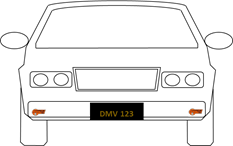
Do not attempt to remove or reposition CAV decals after application. Doing so will destroy the decals.
Displaying CAV decals on your vehicle authorizes you to use HOV lanes and grants toll free and reduced-rate passage on toll bridges in certain areas, even when you are the sole occupant of your vehicle. The CAV Certificate (ID card) must be kept with the vehicles current registration card and presented to a peace officer upon demand.
California law prohibits a vehicle from being issued more than one set of decals, unless the vehicle was involved in an accident and body work affected decal placement, the decals were lost or stolen, or they were not received from DMV.
To apply for replacement CAV decals or ID card:
- Complete the Clean Air Vehicle (CAV) decal application above.
- There is a $22 fee for replacement decals. There is no fee for a replacement ID card.
Replacement decals will be the same color with the same expiration date that were initially issued to the vehicle.
If you find the original CAV decals after you replace them, surrender the originals to DMV with a letter of explanation (for example, you requested a new set of CAV decals, received them, and the missing original CAV decals were found later). Send the original decals and letter to:
Mail to:
Department of Motor Vehicles
Special Processing Unit – MS D238
PO Box 997601
Sacramento, CA 95899-7601
For your CAV decals and ID card to be valid, it is important that the information you have on file with the CAV Decal Program is correct and up-to-date.
Complete the Clean Air Vehicle (CAV) decal application above.
There is no fee for corrections or updates. You will receive a new CAV decal ID card within 21 days.
| Decal Type | Year First Issued | Decal Expires | Description |
|---|---|---|---|
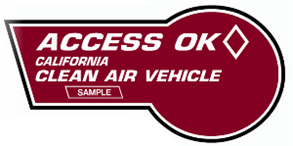 | 11/2023 | 9/30/2025 | These CAV decals are issued to vehicles that meet California’s super ultra-low emission vehicle (SULEV), inherently low-emission vehicle (ILEV) and transitional zero emission vehicle (TZEV) evaporative emission standard for exhaust emissions. Compressed natural gas (CNG) and Liquefied petroleum gas (LPG) fueled vehicles may also qualify for the CAV decal program. Visit CARB’s website at www.arb.ca.gov (Carpool Stickers) for additional information on vehicle eligibility |
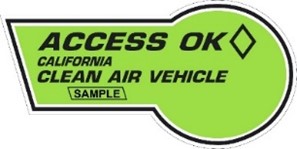 | 2023 | 9/30/2025 | These CAV decals are issued to vehicles that meet California’s super ultra-low emission vehicle (SULEV), inherently low-emission vehicle (ILEV) and transitional zero emission vehicle (TZEV) evaporative emission standard for exhaust emissions. Compressed natural gas (CNG) and Liquefied petroleum gas (LPG) fueled vehicles may also qualify for the CAV decal program. Visit CARB’s website at www.arb.ca.gov (Carpool Stickers) for additional information on vehicle eligibility |
 | 2022 | 9/30/2025 | These CAV decals are issued to vehicles that meet California’s super ultra-low emission vehicle (SULEV), inherently low-emission vehicle (ILEV) and transitional zero emission vehicle (TZEV) evaporative emission standard for exhaust emissions. Compressed natural gas (CNG) and Liquefied petroleum gas (LPG) fueled vehicles may also qualify for the CAV decal program. Visit CARB’s website at www.arb.ca.gov (Carpool Stickers) for additional information on vehicle eligibility |
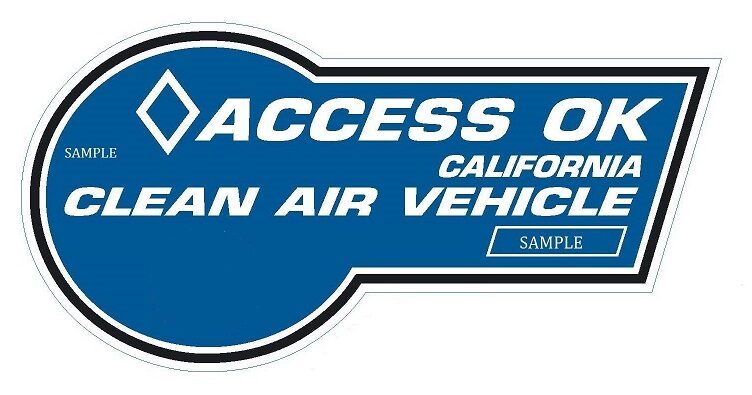 | 2021 | 1/1/2025 | These CAV decals are issued to vehicles that meet California’s super ultra-low emission vehicle (SULEV), inherently low-emission vehicle (ILEV) and transitional zero emission vehicle (TZEV) evaporative emission standard for exhaust emissions. Compressed natural gas (CNG) and Liquefied petroleum gas (LPG) fueled vehicles may also qualify for the CAV decal program. Visit CARB’s website at www.arb.ca.gov (Carpool Stickers) for additional information on vehicle eligibility. |
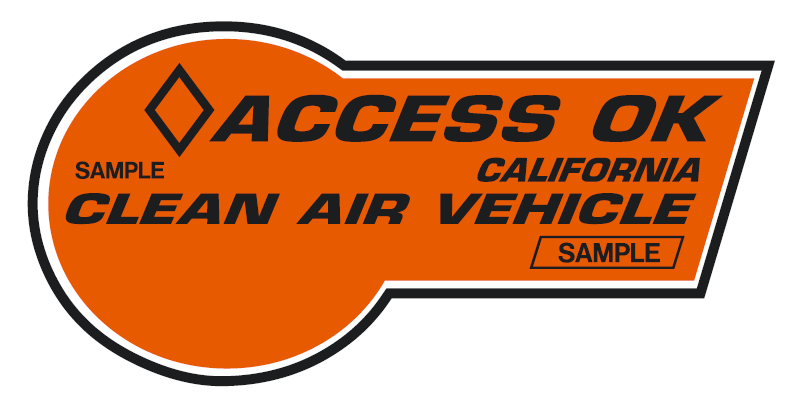 | 2020 | 1/1/2024 | These CAV decals are issued to vehicles that meet California’s super ultra-low emission vehicle (SULEV), inherently low-emission vehicle (ILEV) and transitional zero emission vehicle (TZEV) evaporative emission standard for exhaust emissions. Compressed natural gas (CNG) and Liquefied petroleum gas (LPG) fueled vehicles may also qualify for the CAV decal program. Visit CARB’s website at www.arb.ca.gov (Carpool Stickers) for additional information on vehicle eligibility. |
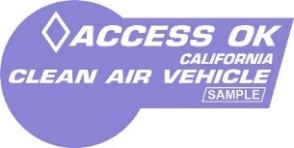 | 2019 | 1/1/2023 | These CAV decals are issued to vehicles that meet California’s super ultra-low emission vehicle (SULEV), inherently low-emission vehicle (ILEV) and transitional zero emission vehicle (TZEV) evaporative emission standard for exhaust emissions. Compressed natural gas (CNG) and Liquefied petroleum gas (LPG) fueled vehicles may also qualify for the CAV decal program. Visit CARB’s website at www.arb.ca.gov (Carpool Stickers) for additional information on vehicle eligibility. |
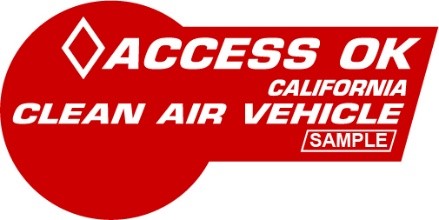 | 2018 | 1/1/2022 | These CAV decals are issued to vehicles that meet California’s super ultra-low emission vehicle (SULEV), inherently low-emission vehicle (ILEV) and transitional zero emission vehicle (TZEV) evaporative emission standard for exhaust emissions. Compressed natural gas (CNG) and Liquefied petroleum gas (LPG) fueled vehicles may also qualify for the CAV decal program. Visit CARB’s website at www.arb.ca.gov (Carpool Stickers) for additional information on vehicle eligibility. |
 | 2012 | 1/1/2019 | Green CAV decals were issued to vehicles that met Enhanced AT PZEV (TZEV standards for exhaust emissions.) Vehicles issued a green decal prior to January 1, 2017, are no longer eligible for this program after January 1, 2019. View the CAV Decal Issued Prior to January 1, 2017 by VIN list and search by VIN to check if the vehicle has been issued a CAV decal. See Income-Based (IB) CAV decal program for possible exception. |
 | 2000 | 1/1/2019 | White CAV Decals were issued to ZEVs, CNG, LPG, and ULEV standard for exhaust emissions and the federal ILEV standard. Ultra-low emission vehicles (ULEVs) are no longer eligible to participate in this program after January 1, 2019. Vehicles issued a white decal prior to January 1, 2017, are no longer eligible for this program after January 1, 2019. View the CAV Decal Issued Prior to January 1, 2017 by VIN list and search by VIN to check if the vehicle has been issued a CAV decal. See IB-CAV decal program for possible exception. |
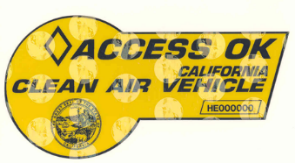 | 2005 | 2011 | These decals were issued to early models of qualifying hybrid vehicles. These stickers were limited to the first 85,000 applicants. |
If you purchased a hydrogen fuel cell electric vehicle on or after January 1, 2018, and your gross annual income is above the thresholds listed above in “Rules, Regulations, and Eligibility”, a CAV decal cannot be issued to you if you have received a consumer rebate through CARB’s Clean Vehicle Rebate Project (CVRP). If your gross annual income is above specified thresholds, you may have to choose between a CAV decal and a CVRP rebate. For additional information, visit CARB’s website at www.arb.ca.gov.
Are paper applications for CAV decals or ID cards accepted?
No, paper applications are no longer accepted for CAV decals or ID cards.
Can I apply for a decal online if I already submitted a paper application?
It depends. Has the check you submitted with your paper application been cashed?
- If cashed, your decal is on the way and you should receive it within 21 days. Do not apply again online.
- If not, you can apply for a decal online and, in doing so, you consent to the destruction of your paper check and application.
Who is responsible for the CAV Program?
The CAV decal program is run by DMV in partnership with CARB. The program allows a vehicle that meets specified emissions standards to display CAV decals and to use HOV (carpool) lanes with only one occupant in the vehicle (see California Vehicle Code (CVC) §§5205.5 and 21655.9).
I want to convert my gasoline powered vehicle to a qualifying fuel type so I can qualify for CAV decals. What are the requirements?
Contact CARB prior to conversion to determine if converting your vehicle is possible and follows current law. For more information visit the CARB website or call 1-800-242-4450. You must obtain a certification from CARB if your vehicle’s motive power was changed as a result of an aftermarket conversion (for example, gasoline to electric). A copy of the CARB certification letter must be attached to the CAV decal application.
If my vehicle is on the CARB Eligibility List, why was my CAV decal application denied?
Your CAV decal application could have been denied for the following reasons:
- CARB indicated that you had applied for or received a rebate from the CVRP for the vehicle and/or you do not meet the income requirements.
- The vehicle was previously issued a CAV decal and not eligible for the new CAV decal Program.
Why is there a “CNG Advisory” on the application for me to “Check Tank Expiration Date” of my CNG vehicle?
The advisory was added to the form to bring to the vehicle owner’s attention that clean vehicles’ natural gas tanks do expire and the dangers of an expired fuel tank. For more information, visit the United States Department of Energy’s Alternative Fuels Data Center (AFDC) website at www.afdc.energy.gov.
I want to apply for a IB-CAV Decal, but cannot find any information on the program. Why?
The authority for the IB-CAV Decal programing ended January 1, 2024.
Need something else?
Title Transfers and Changes
DMV must complete your new vehicle’s transfer of ownership before you can apply for CAV decals.
Register Your Vehicle
To apply for CAV decals, the vehicle needs to be registered in your name.
Update Your Address
The address on your CAV decal application must match the address on the vehicle registration card.
